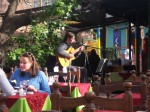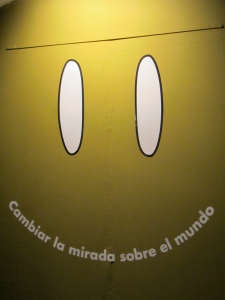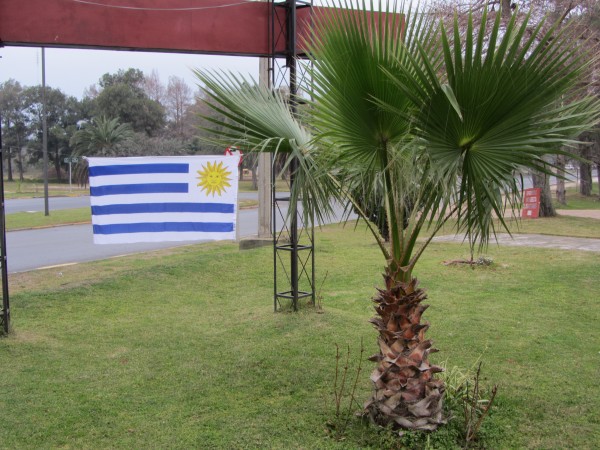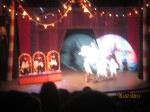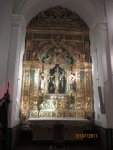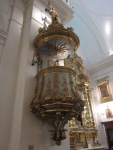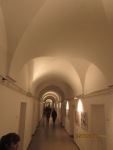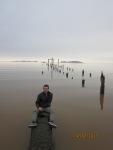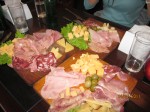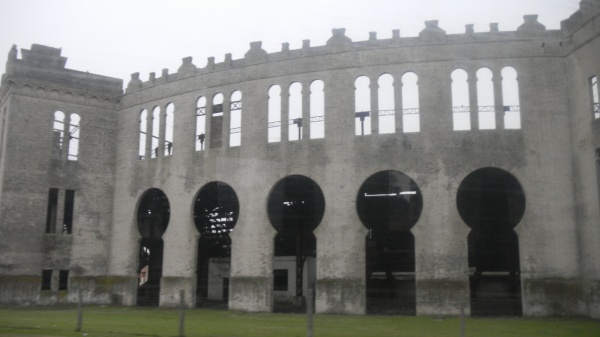Puerto Madero
Puerto Madero
Puerto Madero district offers the best of both worlds. When facing the magnificent “Woman’s Bridge,” on the right hand side, one can reveal the old warehouses and navy ships from the dusts of time. The red brick buildings that were now turned into offices and restaurants, also contained the American bar/restaurant: “Hooters,” and the most famous nightclub in town for upscale peeps: “Asia de Cuba.” The two ships that we witnessed on the harbor, one of which was now the museum of ARA Presidente Sarmiento, were said to have served the purpose of taking navy seals to their ball in order to celebrate the completion of their training. On the left hand side, one could see the horizon of the growing modern construction that included high-rises up to 50 stories tall, which are to home the rich folks who want to distinguish themselves from the rest of the Argentines. Our favorite high-rise was the Hilton Hotel, which we had seen in the movie called: “The Nine Queens,” both of which display the old and new theme of Buenos Aires. This secluded area even has it’s own transportation system, since the local metro, “Subte,” is not good enough; the Madero Tramway is the chic transport for the Puerto Madero folks. Further down the “Silver River,” the landmark of “Woman’s bridge” plays the role of the mediator and connects the two worlds. Completed in 2001, this beautiful work of architect Santiago Calatrava demonstrates the tango of a couple; perhaps, the old and the new world.
Puerto Madero ofrece lo mejor de ambos mundos. Cuando se enfrenta a la magnifica “Puente de la Mujer”, en el lado derecho, uno puede revelar los viejos almacenes y barcos de la Armada de los polvos del tiempo. Los edificios de ladrillos rojos que se convirtieron ahora en oficinas y restaurantes, también contenían el bar americano / restaurante: “Hooters”, y la discoteca más famosa de la ciudad de píos de lujo: ” Asia de Cuba”. Los dos barcos que hemos sido testigos en el puerto, uno de los cuales era el museo del ARA Presidente Sarmiento, y dice que han servido al propósito de tomar de la Fuerza Marina a su bola con el fin de celebrar la finalización de su formación. En el lado izquierdo, se podía ver el horizonte de la construcción que incluye el cultivo moderno rascacielos de hasta 50 pisos de altura, que son las casas de gente rica que quiere diferenciarse del resto de los Argentinos. Nuestro favorito edificio de gran altura fue el Hotel Hilton, que habíamos visto en la película llamada: “Las Nueve Reinas”, ambos de los cuales mostraron el tema viejo y lo nuevo de Buenos Aires. Esta zona apartada, incluso tiene su propio sistema de transporte, ya que el metro local, “Subte”, no es suficiente, el tranvía de Madero es el transporte elegante para la gente de Puerto Madero. Más abajo en el “Río de la Plata”, el símbolo de la “Puente de la Mujer” desempeña el papel de mediador y conecta los dos mundos. Terminado en 2001, esta hermosa obra del arquitecto Santiago Calatrava muestra el tango de una pareja o, tal vez, el viejo y el nuevo mundo.
La Boca
On a Saturday morning we visited the neighborhood of La Boca by taking the 152 colectivo (bus). La Boca is a working class neighborhood that is located at the entrance or mouth of the Riachuelo River, which empties into the Rio de la Plata on the south eastern end of Buenos Aires. Located in La Boca was the first and main port of Buenos Aires where many immigrants from Europe arrived, beginning in the late 1800’s. Many of these immigrants made La Boca their home.
Un Sábado por la mañana decidimos visitar el barrio de La Boca tomando el colectivo 152. La Boca es un barrio de gente trabajadora ubicado a la entrada de Rio Riachuelo cual desemboca en el Rio de La Plata al sur este de Buenos Aries. Históricamente, en La Boca se encontraba el puerto más grande y principal de Buenos Aires en cual los inmigrantes de Europa primero desembarcaban a fines de siglo diecinueve. Muchos de estos inmigrantes hicieron La Boca su barrio.
The colectivo dropped us off at the bus terminal on Avenida Don Pedro de Mendoza that runs alongside to the Riachuelo River. From there we walked to the famous El Caminito pathway located within a street block; the name of the surrounding streets are Garibaldi, Magallanes, Gral. Gregorio Araoz de Lamadrid, and Dr. del Valle Iberlucea. At El Caminito there were many suviners stores, restaurant, and merchants selling artisanal items. Below is a picture of some of these stores and the inside of the restaurant where we ate lunch.
El colectivo nos dejo en la terminal de los colectivos en la Avenida Don Pedro de Mendoza situada al lado del Rio Riachuelo. De la terminal caminamos a la famosa calle llamada el Caminito, localizada entre las calles Garibaldi, Magalles, Gral. Gregorio Araoz de Lamadrid, y Dr. del Valle Iberlucea. En el Caminito hay varias tiendas, restaurantes, y comerciantes vendiendo ropa y productos artesanales. Se pueden ver algunas de estas tiendas en las fotos despues de este párrafo. También hay una foto del restaurante en donde almorzamos.
What impressed most in the Caminito and La Boca where the conventillos which are a type of communal houses that the immigrants built. These houses were painted with different colors and composed of several materials such as wood, brick, and metal. Interestingly, when we arrived to our homestays we read on line that the houses in El Caminito are not the original houses, rather they are a recreation of what the houses looked like when they were built. This recreation was completed by the artist Quinquela Martín who was a native of La Boca. There is a monument in his honor located near the entrance of El Caminito.
Lo que nos impresiono mas del caminito y La Boca fueron los conventillos. Los conventillos eran casas comunales en cuales los inmigrantes vivían. Estas casas fueron construidas por los inmigrantes con diferentes materiales incluyendo tabiques, madera y laminas de metal, también fueron pintadas de diferentes colores. Interesantemente, cuando llegamos a nuestros homestays leímos en el internet que los conventillos del Caminito no son los conventillos originales. Actualmente, los conventillos son una reinterpretación de los conventillos originales cuando fueron construidos. Esta reinterpretación de los conventillos fue realizada por Quinquela Martin, un artista que se había creado en La Boca. Cerca de la entrada del Caminito hay un monumento en honor a Quinquela Martin.
Besides El Caminito, La Boca has other interesting places. One of this is the famous Estadio Alberto J. Armando widely known as La Bombonera Stadium home to the Club Atlético Boca Juniors football team. Unfortunately, we did not have the time to take a tour of the stadium but we did see it from far away as we returned to our homestays. La Bombonera grabbed our attention with its yellow and blue colors and its architecture; the stadium is not completely oval and has non angular side almost giving it a rectangular appearance. Also, in La Boca there are a couple of museums including the Museo de Bellas Artes Benito Quinquela Martín located on Avenida Don Pedro de Mendoza. The museum is also painted with bright colors, but it is not constructed out of the same materials as the conventillos.
Además de tener el famoso Caminito, La Boca también tiene otros lugares interesantes. Uno de estos lugares es el famoso estadio Alberto J. Armando, conocido como el estadio La Bombonera, este estadio es donde juega sus partidos el Club Atletico de Boca Juniors. Desafortunada, no tuvimos tiempo de entrar al estadio pero lo vimos por afuera cuando íbamos de regreso a nuestros homestays. La Bombonera agarro nuestra atención por sus colores amarillos y azules y también por su arquitectura. El estadio no es oval porque tiene un lado que nos es angular dándole al estadio una apariencia rectangular. También, en La Boca se encuentran algunos museos como el Museo de Bellas Artes Benito Quinquela Marin localizado en la Avenida Don Pedro Mendoza. Este museo también está pintado con diferentes colores pero no es de los mismos materiales como los conventillos.
Group C: Marisol Larios, Mara Lopez, David King, Melissa Gutierrez, Marilyn Hsu, Kevin Estupinan, Lorena Murillo
Palace de Glace (Group A: Jen, Leila and Preston)
Palace de Glace
Palace de Glace building certainly gives you a feeling of captivating mystery and a intrigue. The building invites you to come in and explore what it has to offer. The beautiful French styled creation, was copied after Palais de Glace in Paris, France. The building is on the Argentina’s national historical monument list for its beauty as well as for its ever changing purpose. This charming piece of art went from being an ice skating rink to a tango dance floor to a museum in less than 100 years! It’s quite fascinating to know that so many different events took place here throughout the years that shaped Argentine art scene.
Once you’re inside, there’s a wide array of exhibitions ranging from installations by many modern artists culminated by an interesting exhibit of rice. The installation that most stood out were the video of drowned pig peacefully swimming between leaves, trees and flowers.
Another was a modernized “Noah’s Arc” floating van featuringDirectTV satellite receiver to watch those beloved Argentine soccer matches! Yet another image that impacted us was that of landfills and trash in the water, highlighting one of the most important problems of today’s world: our environment.

The overall impression of the museum was extremely positive. After the visit, we conversed about the rice exhibit and how meaningful it was. People in charge of the exhibit did a great job of identifying injustices and false standards that persist in our society today. A great example is that even teenage pop star Justin Bieber can gain more followers on Twitter than the webpage that promises to donate a plate of rice to the homeless! The overall experience was that Palace de Glace is the perfect combination of funky modern art, futuristic creative installations and thought-inducing exhibits!
El edificio del Palacio de Glace, sin duda, da una sensación de cautivante intriga y misterio. El edificio, definitivamente, invita a entrar y explorar lo que tiene que ofrecer. Al ser una hermosa creación del estilo francés, que fue copiada después de Palais de Glace, en París, Francia. El edificio está en la lista de monumento histórico nacional de Argentina por su belleza, así como para su propósito siempre cambiante. Esta encantadora pieza de arte pasó de ser una pista de patinaje sobre hielo a una pista de baile de tango y después a un museo en menos de 100 años. Es bastante interesante saber que acontecimientos tan diferentes se llevaron a cabo aquí durante todo el año la escena en forma de arte argentino.
Una vez que estás adentro, el museo dispone de una amplia gama de exposiciones que van desde instalaciones por muchos artistas modernos culminando con una interesante exposición de arroz. Las instalaciones que más se destacaron fueron el video de cerdo ahogado nadando pacíficamente entre hojas, árboles y flores. Así como un modernizado “Arca de Noé” bus flotante que viene con un receptor de satélite Direct TV para ver los partidos del amado fútbol argentino! Sin embargo, otra imagen que nos impactó fue el de los vertederos y la basura en el agua, destacando uno de los problemas más importantes del mundo de hoy, nuestro medio ambiente.
La impresión general del museo ha sido muy positiva. Después de la visita, hemos conversado sobre la exhibición de arroz y lo significativo que era. Los responsables de la exposición hicieron un gran trabajo de identificación de las injusticias y los falsos cánones que persisten en nuestra sociedad hoy en día. Un gran ejemplo es que el adolescente pop estrella Justin Bieber puede ganar más seguidores en Twitter que la página web que se compromete a donar un plato de arroz a las personas sin hogar! La experiencia de la visita en general fue que el Palace de Glace es la combinación perfecta de funky arte moderno, creativas instalaciones futuristas e instalaciones del arte que te hacen pensar en las cosas verdaderamente importantes de la vida!
Uruguay! (Group A: Leila, Jen, Preston)
URUGUAY: VAMOS CELESTE!
Uruguay, a gorgeous little gem in between Brazil and Argentina. A country that is proud to be celestial and just as proud to be tiny. Land of endless green pastures, “el rincon del viento” or “meadow of wind” how the locals call it due to its mostly flat landscape and the wind. For us, foreigners, this small country was certainly a great discovery of peace and tranquility. Although the poorly organized trip left a huge craving to come explore more, the trip also left us strangely content. Our trip to Colonia, Uruguay only consisted of a visit to the beach, walk on Colonia’s beautiful streets and an unforgettable introduction to Uruguay’s delicious food. Nevertheless, we felt it left a deeper than expected mark in our memories.
The day of our trip to Colonia, Uruguay it was windy and raining the whole time. However, the depressing weather certainly couldn’t keep smiles away from our faces. The charming journey to this country began by boat, and one hour later we’ve reached our destination. Our tour guide, Eugenia, welcomed us and cheered us up with her bubbly personality. We were guided through the streets of Colonia, town where she was born, and were told stories related to its history. After a short introduction, it was time to eat! And Uruguay didn’t disappoint there. Chivitos and chaja got our full approval as well as love.
We must add, that despite of the trip being super short and accompanied by less than desirable weather, we are still in awe. Uruguay got our heart in every way possible. Its small country charm, people and just overall atmosphere. Uruguay is forever in our hearts and thoughts! Go Uruguay Celeste!
Uruguay, una pequeña joya preciosa entre Brasil y Argentina. Un país que es orgulloso de ser celestial y orgulloso de ser pequeño. Tierra de interminables pampas verdes, “el rincón del viento” o “pradera del viento” como los Uruguayos lo llaman debido a su paisaje mayormente plano y el viento. Para nosotros, los extranjeros, este pequeño país fue sin duda un gran descubrimiento de la paz y la tranquilidad. Aunque el viaje mal organizado dejó un enorme deseo de venir a explorar más, el viaje también nos dejó extrañamente contentos. Nuestro viaje a Colonia, Uruguay sólo consistió de una visita a la playa, paseo por las hermosas calles de Colonia y una inolvidable introducción a la deliciosa comida del Uruguay. Sin embargo, sentimos que dejó una huella más profunda de lo esperado en nuestra memoria.
El día de nuestro viaje a Colonia, Uruguay había viento y llovía todo el tiempo. Sin embargo, el clima deprimente no pudo quitar sonrisas de nuestras caras. El viaje encantador a este país comenzó en barco, y una hora más tarde habíamos llegado a nuestro destino. Nuestra guía turística, Eugenia, nos recibió y nos animó con su personalidad burbujeante. Nos guió por las calles de Colonia, su ciudad natal, y nos contaba leyendas relacionadas con su historia. Tras una breve introducción, ya era hora de comer! Y Uruguay no decepcionó allí. Chivitos y chaja tienen nuestra plena aprobación y todo amor.
Debemos agregar, que a pesar de que el viaje fue súper corto y acompañado por el tiempo menos que deseable, todavía sentimos una gran admiración. Uruguay conquisto nuestros corazones en cada sentido posible. Su encanto de un país pequeño, su gente así como la atmósfera en general! Uruguay esta para siempre en nuestros corazones y pensamientos! Vamos Uruguay Celeste!
El gran circo ( jen, emma, blanca, stephanie, raul)
El gran circo
El gran circo es uno de los shows mas prestigioso en todo Buenos aires. Lo fuimos a ver en el monumental teatro Regio. Este show viaja alrededor de todo Argentina, no solo se presenta en buenos aires. La entrada del show fue muy barata ya que el gobierno subsidia esta obra para que la mayoría de los ciudadanos de argentina puedan disfrutar este gran circo. Antes de que el show empesara en la sala de espera había como un tipo de payaso cirquero, el cual tenían escobas un poco graciosas y simulaban limpiar la sala, desde el primer minuto que ponías el pie en el teatro ya tenias un show ya que estos payasos eran demasiado comicos.Este show es una interpretación de un show de sirco, pero los protagonistas son marionetas. Las marionetas son del tamaño de personas, no son las marionetas que todos conocemos. El show es para los niños de argentina pero cuando fuimos pudimos ver que varios adultos también estaban presente, y también se divirtieron como nosotros. Este show es muy original y muy bien organizado ya que los movimientos de las marionetas y las voces siempre fueron sincronizadas y ofrecieron un buen show. Algunos maniobras fueron simples y más que nada carismáticos, pero algunos fueron muy impresionantes como la caja donde las marionetas de niñas chinas estabas bailando en una tarima, después de preguntarnos como le hicieron bajaron la cajita donde estaban bailando y para nuestra sorpresa las marionetas estaban adheridas a los pies de unos acróbatas lo cual hiso ese acto muy impresionante. Todo el show desde el primer minutos hasta e final estuvo lleno de risas, de sorpresas y mucho mas. Todos los niños salieron contentos ya que en la salida escuchamos comentarios de niños los cuales expresaban su felicidad por el show que sus padres los acaban de llevar.
“El gran circo” ( the great circus) is one of the most prestige shows in Buenos Aires. We went to see it in the monumental teatro Regio. This show travels around Argentina, this show is not only shown in Buenos Aires. The entrance of the show was super cheap because the government pays part of the ticket because they want to make this show more accessible to the citizens of Argentina. Before the shows even starts in the main lobby there are this clowns, these clowns had funny brooms and they were simulating cleaning various parts of the lobby, since the first minute you were already emerged into the show thanks to these comical clowns. This show is an interpretation of a circus show, but the main characters are life size puppets these are no regular size puppets that we all know. This show is targeted for the kids but when we went we saw that many adults were present and they were enjoying the show just like we were doing. This show is original and it has great organization since the puppets movements and the voices were synchronized and they were given a good show. Some maneuvers were pretty simple and more than anything charismatic, but some of them were really impressive like the box where there were some puppets dress up as Chinese girls who were dancing and for our surprise this puppets were attached to some acrobat’s feet which made this maneuver really impressive. The whole show from minute one to the ending was full of laughs, surprises and much more. All the kids went out of the show pleased because outside of the theater we heard some positive comments which expressed the happiness on these kids.
Malba ( grupo B emma, blanca, jen, stephanie, raul)
 This museum is considered by many critics to be the best museum in Buenos Aires. The impressive collection has works from great Latin American artists like Frida Kahlo and Diego Rivera as well as famous Argentine painters like Xul Solar, Antonio Berni, Jorge de la Vega, etc. Our group was impressed with all the artwork in the museum but we were especially enthralled with the exhibit on Latin American Art from the 20th Century. This exhibit was incredibly impactful because the works were largely conceptual pieces that examine modern society. For example, the painting by Antonio Berni, entitled Demonstration, depicts a crowd of citizens protesting from the 1930s. As viewers we were able to see in clarity the weathered faces and dejected eyes of the workers and we couldn’t help but feel sympathy for these people and then anger that the government had neglected to serve their citizens well. Looking at the painting through a modern lens, the same injustices are present today but are we participating in the governmental process like the citizens in the painting? The answer for many of us, is no.
This museum is considered by many critics to be the best museum in Buenos Aires. The impressive collection has works from great Latin American artists like Frida Kahlo and Diego Rivera as well as famous Argentine painters like Xul Solar, Antonio Berni, Jorge de la Vega, etc. Our group was impressed with all the artwork in the museum but we were especially enthralled with the exhibit on Latin American Art from the 20th Century. This exhibit was incredibly impactful because the works were largely conceptual pieces that examine modern society. For example, the painting by Antonio Berni, entitled Demonstration, depicts a crowd of citizens protesting from the 1930s. As viewers we were able to see in clarity the weathered faces and dejected eyes of the workers and we couldn’t help but feel sympathy for these people and then anger that the government had neglected to serve their citizens well. Looking at the painting through a modern lens, the same injustices are present today but are we participating in the governmental process like the citizens in the painting? The answer for many of us, is no.
Este museo es considerado por muchos críticos como el mejor museo en todo Buenos Aires. Este museo tiene muchas obras de arte e artistas muy famosos de toda latino América como Frida Kahlo y Diego Rivera, también tiene artistas de la nación argentina como los pintores Xul Solar, Antonio Berni, Jorge de la vega,etc. Nuestro grupo se impresiono demasiado con todo el arte a disposición de nuestras pupilas, el área que más nos llamo la atención fue el área de el arte de Latinoamérica de el siglo 20.Esta exposición fue impresionante porque las obras de arte reflejaban lo que estaba pasando en nuestra sociedad en estos momentos. Un ejemplo seria la pintura de Antonio Berni, titulada como Demonstración, en ella se puede ver una maza de ciudadanos que estaban protestando en los anos de los treintas. Nosotros como observadores podemos ver la claridad en las caras húmedas y los ojos abatidos de los trabajadores, no nos quedaba de otra más que sentir simpatía por esas personas y lo admitimos también sentimos un poco de rabia por el gobierno ya que les negó un buen trato a sus ciudadanos. Cuando miramos este arte con nuestros ojos de un siglo más moderno, las mismas injusticias están presente hoy en día, pero nos preguntamos si estamos haciendo las mismas protestas como los ciudadanos que están en aquella pintura? La respuesta para la mayoría de nosotros es no.
Today our group first went to a Catholic church in Recoleta called Pilar. It was founded in 1732 and is the second oldest church in Buenos Aires. It seemed we had picked the perfect time to view it as the sun set behind it, casting its snowy white façade against panoply of pinks, lavenders, and the last remnants of blue from the day’s sky. Winding paths of bright flowers led us into the church where almost immediately all the sounds of the city ceased. There were tourists and worshippers alike as some (like us) took quiet photos and others bowed their heads or visited the priest in a confessional. The ceiling arced up high above our heads and several panels of different scenes depicting Christ and the Virgin Mary elaborately decorated each side of the church, with an image of Christ on the cross at the front of the church. A message and picture from the Pope were set on one of the displays against the wall. After enjoying the peace and quiet, we headed off to a cultural center nearby in Recoleta with an interesting display of art. While some rooms of art, at least in our opinions, seemed silly with photos that we could have taken ourselves, there were several rooms of photography, paintings and comic book type displays that were extremely powerful and intriguing. We all walked slowly down the main hall that was blanketed with paintings of comic book strips discussing, most frequently, the bombing of the AMIA (Argentine Israelite Mutual Association) building in 1994. It killed 85 people and injured many others. Most of the “comic” strips that discussed the bombing seemed to criticize the lack of attention given to the issue, as the Jewish community in Argentina is the largest in Latin America with 200,000. In addition to Argentine culture, there was a room dedicated to a tribe in Mali with no written language. A photographer documented their lives and several captions explained certain customs they have, giving attention and a voice to a remote tribe in Africa.
Hoy nuestro grupo primero fue a la iglesia en Recoleta llamada Pilar. Fue fundada en 1732 y es la segunda iglesia mas antigua en buenos aires. Parece que escogimos el tiempo perfecto para visitar este lugar ya que nos toco ver el cuando bajaba el sol detrás de este iglesia, con su estructura de color blanco esta fachada hacia la puesta del sol un poco mas esplendorosa. Había un jardín muy hermoso el cual nos llevaba hacia donde esta iglesia se encontraba, también notamos que cuando te acercas mas a esta iglesia los sonidos de la ciudad desaparecen. Había turistas y seguidores de la iglesia también, ya adentro tomamos varias fotos y otros decidieron confesarse o hablar con dios por algunos segundos. El techo con su arco esplendoroso estaba arriba de nosotros, en estos arcos se podía ver diferentes detalladas pinturas las cuales mostraban a a Dios y la virgen maría, también había la típica imagen de dios con su cruz en la mitad de la iglesia. Había una foto y un mensaje del papa en un rincón de esta iglesia. Después de disfrutar el silencio y la gran paz que tenia este lugar nos dirigimos al centro cultural Recoleta. Mientras que algunos cuartos de arte, según nuestra humilde opinión, eran un poco tonto con fotos que nosotros podríamos tomar. También había varias recamaras de fotografía, pinturas, y exposiciones que parecían sacadas de tiras de comics las cuales tenían un mensaje muy poderoso e intrigador. Todos caminamos despacio hacia el pasillo principal el cual estaba forrado con pinturas estilo comic, las cuales eran un poco grotescas, la mayoría se refería hacia las bombas que se detonaron en el edificio de AMIA (Argentine Israelite Mutual Association) en 1994.Estas bombas mataron 85 personas y lastimaron muchas mas. La mayoría de los comics discutían la poca atención que se le dio a este asunto, ya que la comunidad judía en argentina es la mas grande en Latinoamérica con 200,000 seguidores. No todas las obras se referían sobre la cultura argentina, había un cuarto dedicado a la tribu en Mali la cual no gozaba de un lenguaje escrito. Un fotógrafo documento sus vidas y había varias leyendas que explicaban varias costumbres que tenían.
Colonia uruguay ( grupo B emma, jen,stephanie,blanca, raul)
Our trip to Uruguay started early in the day. We meet at the boat station.Our boat left the station at 8:45 AM. The trip lasted for an hour, it was a very relaxing trip. Once we reached Uruguay we got into a bus that took us to an amazing bay where we were able to take various pictures with one of the best backgrounds we have seen so far in this program. Then we were given a tour by bus where we were able to see the first bull fighting stadium in all Uruguay. After the short trip by bus we walked a very traditional plaza in Uruguay where there was a cathedral and one of the first streets in Uruguay where legend says if you walk down and up in this street tree times all your love wishes will come true. Most of the trip on Uruguayan soil we spend it in a restaurant. In this restaurant we tasted various plates such as picada which is a bunch of various meet and cheeses such as salami, ham, longanisa , American cheese, Parnassian cheese and many more. For the main plate most of the people choose “chivito” which is goat. They made a hamburger where the meat was made from goal, in this hamburger they also put and egg, mayonnaise, ketchup, tomatoes. For dessert we had the option of ice cream or flan.
It was a shame that the trip went bad because of the rain. When we were eating it started to rain. Once we were done eating we had nowhere to go and exp
lore the city since we didn’t wanted to get wet. At the end it wasn’t an option not to get wet, since we had to run back to the bus in the middle of a heavy rain. Funny story, once the whole group got into the bus it stop raining. After that we return to Buenos Aires by boat and that was pretty much it for our day in Uruguay.
Nuestra gran travesía para llegar al país de Uruguay empezó a muy temprana hora. Nos reunimos en la estación de botes.Nuestro bote embarco a las 8:45 AM. El viaje duro aproximadamente una hora, en realidad fue un viaje muy calmado. Cuando llegamos a Uruguay nos subimos a un autobús el cual nos llevo a una bahía sorprendente para la pupila de cualquier hombre que le encanta la naturaleza, en esta bahía tuvimos la oportunidad de tomar varias fotografías con uno de los mejores paisajes que hemos visto hasta ahora en este programa. Después regresamos al camión y dimos una vuelta por la ciudad en la cual tuvimos el privilegio de admirar el primer estadio de todo Uruguay en donde se celebraba la corrida de toros. Después de esta gran expedición en el camión, el grupo tuvo el privilegio de caminar por una pintoresca plaza muy impresionante donde se podía ver rastros de arquitectura española. En esta plaza se encuentra una calle mística, la razón por la que digo mística es porque hay mitos los cuales dicen que si bajas y subes por esta calle mística 3 veces todos tus sueños relacionados con el amor se volverán realidad. La mejoría del viaje hacia la gran nación de Uruguay nos la pasamos refugiados en un restaurante. En este peculiar restaurante se podía ordenar varios platillos pero en los más destacados están la picada, la cual es una tabla de madera con varios tipos de carnes y quesos como el jamón, la longaniza, queso americano, el queso parmesano por tan solo mencionar algunos. El plato principal más popular sin lugar alguna y por votación unánime fue el “chivito”. La forma en la que fue presentada a nuestro paladar fue en forma de la tradicional hamburguesa. Esta hamburguesa no fue cualquier hamburguesa ya que venía con producto de gallina. La verdad ese pequeño toque de blanquillos le dio un sabor más exquisito que estaba para chuparse los dedos.
La verdad fue una desgracia que se nos viniera el cielo en sima en forma de gotas cuando estábamos disfrutando de nuestra estancia en Uruguay. No pudimos evitar empaparnos ya que cuando salíamos de el restaurante tuvimos que correr hacia el camión ya que tenía prisa. Algo gracioso es que cuando todo el grupo estaba montado ya en el camión, paro de llover. Algo un poco irónico lo que cree usted?
Colonia, Uruguay (Grupo C)
El viernes, 15 de Julio del 2011, nuestro grupo fue a Colonia, Uruguay para una excursión. Nos encontramos en el amanecer en una estación de BuqueBus para embarcar en una aventura. Era un dia muy nubloso y hacia mucho frío. Nos subimos a un transbordador enorme y hasta tenia tiendas en el primer nivel. Viajamos por una hora y media y cuando desembarcamos nos fuimos en un ómnibus donde una señora nativa nos dio una gira turístico de la ciudad de Colonia. Después de un rato de pasearnos por la ciudad nos bajamos a caminar y fue relajante a poder caminar a nuestro paso y disfrutar mas de la belleza de Colonia. Es una ciudad pequeño con mas de los ciudadanos viviendo en el capital de Montevideo. De todas las ruinas que encontramos se parecía como una cuidad antigua y inspirada por los europeos. Después de caminar fuimos a cenar en un restaurante donde sirvieron muy buena comida y mucha. Durante la cena empezó a llover muy fuerte y después que todos comieron nos fuimos al ómnibus para regresar a la estación. Nos mojamos todos y la lluvia no nos permitió a completamente disfrutar de la ciudad. Nos regresamos a la estación de BuqueBus y nos regresamos a Buenos Aires. Sobre todo fue una experiencia inolvidable.
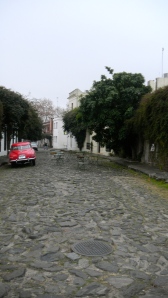 On July 15, 2011, our group went to Colonia, Uruguay for an excursion. We met up at dawn at the ferry station to embark on our adventure for the day. It was really cloudy and cold. We boarded an enormous ferry that even had stores on the first level. We were traveling for an hour and a half and when we got to the Colonia station we got on a private bus where a native lady gave us a tour of the city of Colonia. After a while of being on the bus and driving through the city we got off and walked which was relaxing to be able to walk at our own pace and be able to fully enjoy the beauty that Colonia offered. It is a small city with most of Uruguay’s citizens residing in the country’s capital, Montevideo. From the many ruins we encountered it looked like an old city that was greatly influenced by the European. After our walking tour we went to have dinner in a restaurant that served great food and the proportions were generous. During dinner however, it started pouring rain and we had to return back to the bus to head back to the ferry station. We all got soaked and the rain did not allow us to fully take in all of the beauty of the city. We returned to the ferry station and we returned to Buenos Aires. Overall it was an unforgettable experience.
On July 15, 2011, our group went to Colonia, Uruguay for an excursion. We met up at dawn at the ferry station to embark on our adventure for the day. It was really cloudy and cold. We boarded an enormous ferry that even had stores on the first level. We were traveling for an hour and a half and when we got to the Colonia station we got on a private bus where a native lady gave us a tour of the city of Colonia. After a while of being on the bus and driving through the city we got off and walked which was relaxing to be able to walk at our own pace and be able to fully enjoy the beauty that Colonia offered. It is a small city with most of Uruguay’s citizens residing in the country’s capital, Montevideo. From the many ruins we encountered it looked like an old city that was greatly influenced by the European. After our walking tour we went to have dinner in a restaurant that served great food and the proportions were generous. During dinner however, it started pouring rain and we had to return back to the bus to head back to the ferry station. We all got soaked and the rain did not allow us to fully take in all of the beauty of the city. We returned to the ferry station and we returned to Buenos Aires. Overall it was an unforgettable experience.
Teatro Regio (Group A: Leila, Preston, Jen)
Teatro Regio
It is funny to say that we were lucky to experience something as unique, local, and unexpected as the children’s puppet show at the Teatro Regio in Chacarita. Although some of us (i.e. Preston) have horrible nightmares at the mere mention of puppets and clowns, the ones we saw in “El Gran Circo” were hardly nightmare inducing and the show was actually quite entertaining.
The Teatro Regio is an antique piece of the city. By looking at the building, one can tell that it has shown many, many plays over the years. The original sign still hangs outside of the theater, which evokes a sense of historical significance and cultural value. Built in 1929 and currently owned by the government of the city of Buenos Aires, the theater has two floors filled with seats, theater boxes, and, of course, the stage. In the theater’s lobby there is also a beautifully painted, colorful ceiling with caricatures of clowns and other exaggerated, dragged characters.
The show we saw, “El Gran Circo,” was a children’s puppet show parodying a typical circus show. The show was conducted by a group of talented puppeteers who performed various acts in the circus, from a weight-lifting strongman, to dancing animals and the ubiquitous clowns. One of the most interesting acts in the show was a performance of “Japanese dancers,” that were puppets placed on the legs of puppeteers as they sat hidden in boxes behind the puppets. Another impressive act involved a couple dancing the tango, which was eventually revealed to be a single puppeteer in costume performing as both dancers. Overall, the quality of the performance was much better than we expected it to be, and we enjoyed the cuteness and novelty of seeing such a well-performed show.
Es gracioso para nosotros decir que tuvimos la suerte de ver algo tan único, local, y inesperado, como el espectáculo de títeres para los niños en el Teatro Regio en Chacarita. Aunque algunos de nosotros, por ejemplo, Preston, tenemos pesadillas horribles con la sola mención de los títeres y payasos, los que vimos en “El Gran Circo” no nos causan pesadillas y el espectáculo fue bastante entretenido.
El Teatro Regio es una pieza antigua de la ciudad de Buenos Aires. Mirando el edificio, uno puede decir que ha mostrado muchos espectáculos a través del tiempo. El rótulo original del teatro aún cuelga fuera de este, lo que evoca un sentido de importancia histórica y valor cultural. Construido en 1929 y de propiedad del gobierno de la ciudad de Buenos Aires, el teatro tiene dos pisos llenos de asientos, palcos, y, por supuesto, el escenario. En el vestíbulo del teatro también hay un colorido techo con caricaturas de payasos y otras exageradas y arrastradas caracteres.
El espectáculo que vimos, “El Gran Circo”, era títeres para los niños que mostraba una parodia de un espectáculo de circo típico. El espectáculo se llevó a cabo por un grupo de titiriteros talentosos que actuaron diversos actos en el circo, de un hombre fuerte que levanta pesos, a los animales que bailan y los payasos ubicuos que actúan. Uno de los actos más interesantes del espectáculo fue la actuación de “bailarines japoneses”, que eran títeres colocados sobre las piernas de los titiriteros que se sentaron en cajas ocultas detrás de los títeres. Otro acto impresionante involucrada una pareja bailando tango, que finalmente se revela que un titiritero solo en traje actuando como ambos bailarines. En general, la calidad del número fue mucho mejor de lo que esperábamos que fuera, y disfrutamos de la astucia y la novedad de ver un espectáculo tan bien realizado.


